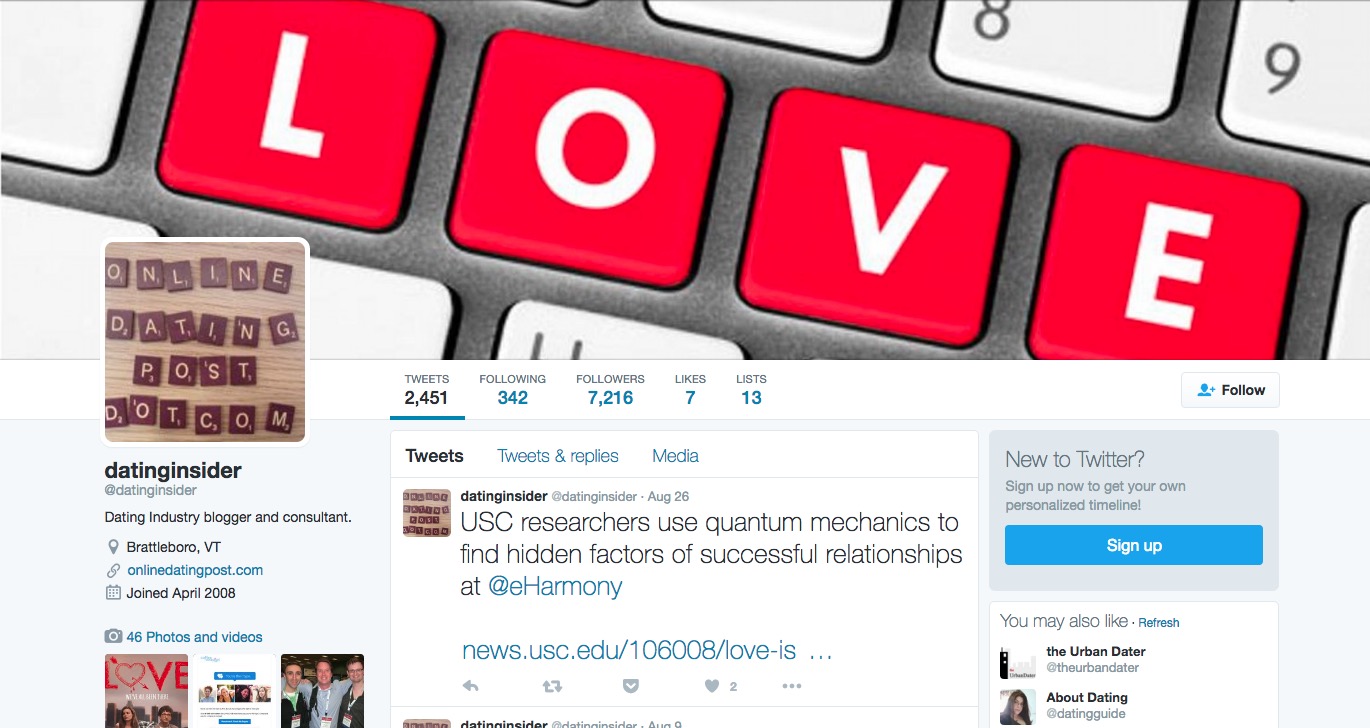Online Personals Watch has published what I consider the most interesting interview I’ve ever read on that particular blog. Read what David Siegel has to say about starting a dating site based on the semantic web.
First, I recommend pointing your browser at the Semantic Web Wikipedia entry to wrap your brain around the concept.
As someone who started following the topic of a semantic web since going to a few MIT meetings in 2002, I thoroughly enjoyed the article. In fact, I wrote Semantic Web meets online dating in July of 2004. Match.com gets members tagging is relevant as well. Also see ProfileLinker Offers Portable Profiles, Online Dating in 2012 (circa 2007) and this blogs innovation category for more.
Much like when I was deep into virtual reality in the early 90’s, online dating is a fascinating confluence of many different remarkable people, ideas, business models and influences. I just love it when people tie themes of Internet search, technology platforms, emerging trends and the like to online dating.
David’s concept of One Single Profile is a great idea, one I’ve written about countless times from various perspectives over the years, from the dating as well as identity standpoint (see above links).
Lots of insider baseball terminology, but don’t let it scare you. Interesting to the semantic web discussed in the context of dating sites. I tried not to use the phrase so as to not scare people off, maybe if enough people grok the concept, some intrepid entrepreneurs will take it upon themselves to bake semantic/cloud/identity features into a new breed of dating sites as David plans to do.
Of all the things one could accomplish with Semantic Web technology, interesting that a well-known business guru is talking about creating a dating site. That’s at least $10 million to get going right there. If you’re going to change the game, you have to go big. Really big.
Organizing all the data on the Internet from the bottom-up? Never gonna happen. It’s going to be a top-down situation, where Goog and FB and others structure the data and make it accessible to new classes of web services which take advantage of Semantic Web. We’re building the majority of our websites with HTML4, which is from the late 1990’s, for crying out loud.
Problem with all of this is that consumers like anonymity and they don’t always trust their personal data in the cloud, regardless of how secure it may be. Forward movement is being made though. Check out a new open source project called Grendel that makes it easy for web apps to encrypt data using the user’s login password, and only decrypt that data when the user is logged in. Lots of variations on this theme are emerging, although getting sites to implement these concepts is going to take a long time. (See OpenID and Facebook Connect).
This statement gave me pause, “if I’m on eHarmony, I ought to be able to move my dating profile to another dating site or to my personal data locker and then manage it from there.” David, I think you need my “expectation alignment” sermon in regards to the dating industry. I’m certainly not holding my breath for an “export” button on a paid subscription site. Fix the damn matching algorithm first, priorities, please.
Interesting to see David switch talk about how identity fits into the big picture (Identity Gang, Higgins and a whole lot of other stuff I won’t go into here.) I used to go to these steering group meetings years ago. If you want to learn about identity, a good place to start is Identity Commons.
Funny how the title of David’s new book contains the word Pull, yet he advocates dating matches being pushed without having to log into a specific dating site. Semantics, ha. But he’s right about that and the whole dashboard concept. Another thing I’ve mentioned about a million times here.
I’ve always said there should be a single repository of profiles, and a vibrant ecosystem of vendors building search, safety and dynamic profile services. Problem is, everyone yells about how great niche sites are. Niche sites are only any good because they are the only alternative to big-box retailer dating sites.
Once you have a Semantic Web-based dating site (whatever that is going to look like), you can create niche sites on the fly, in real-time. Oh and by the way, these next-generation dating sites are not going to rely on Google and Bing and Yahoo and ad networks to drive users. Wednesdays Google presentation on Adwords at iDate is going to be a quaint relic in a few years. this is good because hopefully it will reduce new member acquisition costs, hurray.
Think about the Twitter and Facebook ecosystem, which while tiny in terms of overall revenue, is the direction things appear to be heading. Utility player creates the technology, marketing hype, partner ecosystem and all the rest of the underpinnings and other companies create the services that operate on the datastream.
I think my imaginary matching algorithm is better than anything Fernando can cook up (see comments on original post). I say, great! Throw it out there and let the people choose one or the other due to it being more effective, or fun or cheaper (incremental introduction billing and communication channels).
David mentions FOAF, which is tired metadata standard from many years ago, but he’s got the right idea. I’ve had my FOAF file on this blog for seven years.
A semantic web-base dating site is truly a blue ocean strategy at work, but this change-resistant industry won’t play by the new rules, it’s going to be people like David Siegel who push things forward. And Thread and its variants, and Gelato, and on and on.
Can a business expert, author and big-thinker actually launch a successful dating site based on the properties of the Semantic Web? It sure is going to be fun to watch. Even if he fails, the cat will be out of the bag, so to speak, and we’re never turning back.
I could talk about this for hours on end. Insightful post, thanks to OPW for interviewing David. Want more? Read David’s book, Pull: The Power of the Semantic Web to Transform Your Business. Then, contact me and let’s start challenging the status quo.

